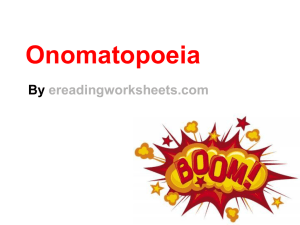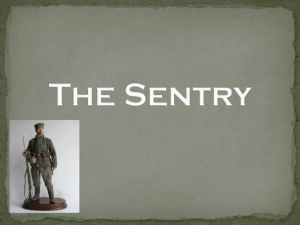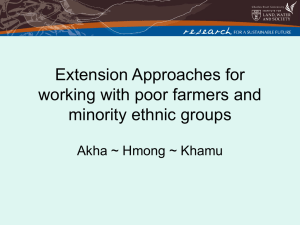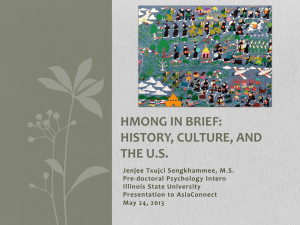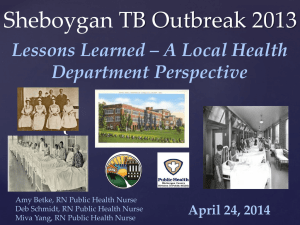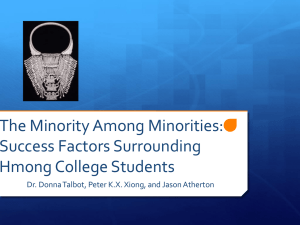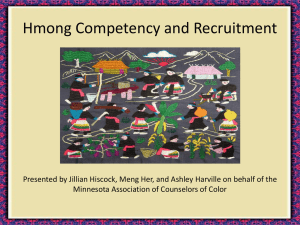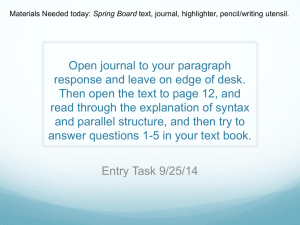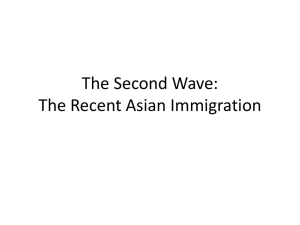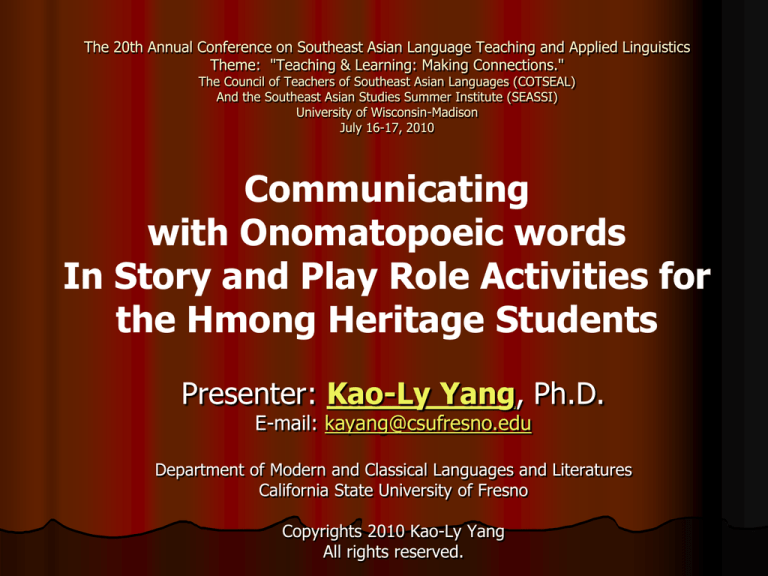
The 20th Annual Conference on Southeast Asian Language Teaching and Applied Linguistics
Theme: "Teaching & Learning: Making Connections."
The Council of Teachers of Southeast Asian Languages (COTSEAL)
And the Southeast Asian Studies Summer Institute (SEASSI)
University of Wisconsin-Madison
July 16-17, 2010
Communicating
with Onomatopoeic words
In Story and Play Role Activities for
the Hmong Heritage Students
Presenter: Kao-Ly Yang, Ph.D.
E-mail: kayang@csufresno.edu
Department of Modern and Classical Languages and Literatures
California State University of Fresno
Copyrights 2010 Kao-Ly Yang
All rights reserved.
Outline of the Presentation
1.
2.
3.
4.
Some Features of the Hmong Language
Teaching Issues
Classification and Parts of Speech
Teaching Story Writing and Play Role in
Using Onomatopoeic Words
1
SOME FEATURES OF THE HMONG
LANGUAGE
The Hmong belongs to the Miao-Yao or HmongMien family of language, originally from China
Monosyllabism: One syllable = one meaning
Tonal Language: in Southeast Asia and in the
West, the Hmong language has 7 tones + one
variable. The tones are transcribed with
consonants
Language using Latin alphabet.
60-year written tradition (The language has a
very rich oral tradition)
2. TEACHING ISSUES
In the Hmong oral literature, either in
folktales or sung poetry, there are words
or groups of words that are difficult to
define in term of meaning.
They are mainly onomatopoeic words.
Research and teaching approach:
1.
Using French and Japanese grammars and
Sound symbolism or phonosemantics to
identify and classify:
The type of sound/soudless-imitating words
The grammatical nature of the words, otherwise
parts of speech.
The grammatical function of the words (or
group of words) designating their role in
relationship to other words in the sentence.
2.
Find the appropriate activity to teach them:
here in story writing and play role
3. CLASSIFICATION
AND
PARTS OF SPEECH
OF THE ONOMATOPOEIC WORDS
Terminology and Definitions
An “onomatopoeia” is a figure of speech copying
natural sounds.
Examples for the cry of pain
(English): ouch, ow
(French): aïe, ouille
(Hmong): uaj
Under the terms of « onomatopoeic word », are
included
(See the following page for explanations and
examples)
Classifications
1.
Phonomimes:
Sound-imitating words or onamatopoeias
Sound ending a statement at the oral level:
2.
Example: (sound made when walking on a wood floor): “tig toog”
Example: (finishing a part of the story): Ces nws mus “lo” (Then
she or he goes on.)
Phenomimes: (Mimetic Words that represent soundless states or
events) :
Example #1: (Enhancing the color black): Dub « nciab » (black
deep= dark)
Example #2: (A group of people starting to move): Mus kev « zom
zaws » (Starting to walking in moving as a group)
Psychomimes (Mimetic words that represent psychological states or
bodily feelings):
Example #1: (Describing an angry attitude): Dub “lus” (black
3.
“lu”= angrily)
Example #2: (Doing something while watching from left to right or
right to left, and back and forth in a romantically way): Ntsia “yuj
yeev” (Watching romantically from left to right and right to left)
Parts of Speech
Interjection: Uaj! (Ouch!)
Oral punctuation: Nws mus lo (S/he is
going!)
Adverbs (« Sound adverb »): Nws khiav
tig toog. (S/he runs in making the noise
« tig toog. »)
Adjectives: Plaub hau dub nciab. (The
hair is dark.)
4
TEACHING
WITH THE ONOMATOPOEIC WORDS
STUDENTS’ PROFILES:
Heritage Students – born in Laos, in Thailand, and in
the US)
Intermediate Level (at least two semesters of Hmong)
Students’ professional goals: Mostly to become
bilingual teachers and/or Hmong teachers
(The author has started to teach story and play role in
incorporating onomatopoeic words from 2006 to now)
STORY AND PLAY ROLE ACTIVITY
OBJECTIVE:
1.
2.
Writing a 500-word short-story with dialogue and
soundtrack (a “3D-story”) in using onomatopoeic
words.
Adapting some of the stories into play roles in
producing the soundtracks and in acting.
TIMING: 3 week activity (3 x 50 min/ week)
EVALUATIONS:
1.
2.
Production of a complete story accordingly to the
guideline with edition (wrong spellings, writing
style).
Rewriting of a story into a play role , and
participation to the play.
APPROACH (Part 1): Reading and Grammar
1. Read
a folktale (authentic text) and highlight
the onomatopoeic words (in addition to its
literal and literary study).
2. Classify
onomatopoeic words according to the 3
groups (phonomime, phenomine, psychomine):
establish a list to be used.
3. Learn
to use them formally in some structured
grammatical exercises (emphasis on meaning
and grammatical uses).
APPROACH (Part 2): Story Writing
Assign specific topics with actions (Possible
themes: Fight between boy-friend and girlfriend, or couple, employee-boss, etc.)
Assign students to write the 500-word story
where they must add at least 20
onomatopoeic words from the list.
Instructor corrects individually the stories:
students are required to correct errors, and if
necessary, to add additional onomatopoeic
words.
APPROACH (Part 3): Play role
1.
2.
3.
4.
5.
6.
4 students (at least) choose one of their
stories
Rewrite it with dialogue and soundtrack
(using the onomatopoeic words to create a
specific soundtrack for the play role)
Each group corrects its play with the
instructor’s help
The whole class discusses about the writing
process and the soundtrack
Rehearsing
Playing
Conclusion
Outcome at the Learning level:
The learning of the onomatopoeic words enriches
students’ vocabulary, enhances their reading
comprehension of folktales, and creative writing skills
Students like this activity: the onomatopoeic words
bring fun and excitement, so motivate them to learn
Outcome for future teacher’ training:
Knowing that the Hmong language doesn’t have yet
appropriate materials to teach, this teaching approach
combining research and teaching --from identifying
the onomatopoeic words to play role-- will develop
more interest and understanding on behalf of the
future teachers to develop appropriate teaching
materials.

